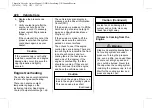
Chevrolet Corvette Owner Manual (GMNA-Localizing-U.S./Canada/Mexico-
12470550) - 2020 - CRC - 12/17/19
228
Vehicle Care
6. Replace the pressure cap
tightly.
7. Verify coolant level after the
engine is shut off and the
coolant is cold. If necessary,
repeat coolant fill procedure
Steps 3
−
7.
If the coolant still is not at the
proper level when the system
cools down again, see your
dealer.
Caution
If the pressure cap is not tightly
installed, coolant loss and engine
damage may occur. Be sure the
cap is properly and tightly
secured.
Engine Overheating
The vehicle has several indicators
to warn of engine overheating.
There is an engine coolant
temperature gauge on the
instrument cluster. See
.
The vehicle may also display a
message on the Driver Information
Center (DIC).
If the decision is made not to lift the
hatch but to get service help right
away, see
.
If the decision is made to lift the
hatch, make sure the vehicle is
parked on a level surface.
Then check to see if the engine
cooling fans are running. There are
two cooling fans located in the front
(one at each corner) and two
cooling fans in the rear (one on
each side of the engine). If the
engine is overheating, the fans
should be running. If they are not,
do not continue to run the engine,
and have the vehicle serviced.
Caution
Do not run the engine if there is a
leak in the engine cooling system.
This can cause a loss of all
(Continued)
Caution (Continued)
coolant and can damage the
system and vehicle. Have any
leaks fixed right away.
If Steam Is Coming from the
Engine
{
Warning
Steam and scalding liquids from a
hot cooling system are under
pressure. Turning the pressure
cap, even a little, can cause them
to come out at high speed and
you could be burned. Never turn
the cap when the cooling system,
including the pressure cap, is hot.
Wait for the cooling system and
pressure cap to cool.
















































